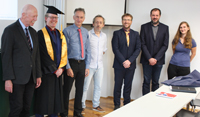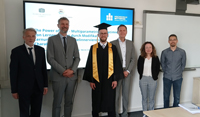| 2025 | 2024 | 2023 | 2022 | 2021 | 2020 | 2019 | 2018 | 2017 | 2016 | 2015 | 2014 | 2013 | 2012 | 2011 | 2010 | 2009 | 2008 | 2007 | 2006 | 2005 | 2004 | 2003 | 2002 | 2001 | 2000 | 1999 | 1998 | 1997 |
Promotionen der Fakultät für Informatik im Jahr 2024
|
04.12.2024 Zhang, Mingqing Gutachter: Prof. Dr. Alejandro Masrur (Technische Universität Chemnitz), Dr. Gangolf Hirtz (Technische Universität Chemnitz, Fakultät für Elektrotechnik und Informationstechnik)
|
|
|
Abstract: The automotive industry heavily relies on the controller area network (CAN) due to its low cost and robustness. However, as vehicle connectivity grows, CAN buses become more vulnerable to cyberattacks such as spoofing, sniffing, replay, and denial of service (DoS), compromising both safety and (cyber-)security. Most existing attempts to secure CAN buses necessitate modifications to the hardware or protocol, which increase costs and complicate implementation, or they employ security schemes that negatively impact timing behavior and safety for both passengers and other road participants. To address this problem, we first propose a safety/security co-design approach based on combining a technique we call periodic authenticated encryption. On the other hand, DoS attacks on CAN buses can typically only be mitigated rather than completely rejected, due to CAN's inherent characteristics. We hence propose a priority-raise approach to this aim. Further, securing CAN buses requires sending additional frames, which frames undergo individual arbitration processes, further increasing delay. To alleviate this situation, we propose an ID mirroring technique. Finally, to accommodate to varying timing requirements in safety-critical applications, we propose a dynamic encryption switching approach. To evaluate the efficacy of these techniques, we conducted experiments on real hardware and carried out extensive simulations using MATLAB/Simulink and OMNeT++. Additionally, we presented various case studies involving electronic stability control (ESC), emergency braking, adaptive cruise control (ACC), and cooperative driving. Our findings demonstrate that the proposed techniques effectively reduce transmission delays while mitigating or preventing all major cyberattacks on the CAN bus. Furthermore, these techniques enable us to meet typical automotive deadlines on CAN buses, fulfilling both safety and security requirements within automotive systems. |
|
|
02.10.2024 Dinkelbach, Helge Ülo Gutachter: Prof. Dr. Fred Hamker (Technische Universität Chemnitz), Dr. habil. Nicolas Rougier (Institut des Maladies Neurodegeneratives; Centre Broca Nouvelle-Aquitaine)
|
|
|
Abstract: Computational neuroscience is a rapidly developing field exploring the principles of information encoding and decoding in neural systems and trying to understand the brain on a functional level. The ongoing research in this field leads to models increasing in size and complexity. Modern multi-core CPUs and GPUs offer increasing computational power on shared memory systems. Neural simulators should help to make use of this parallel computational power for the simulation of biologically inspired networks. Developing such neural simulators demands a good understanding of both models of biologically inspired networks and current hardware architectures. The simulation of rate-coded and spiking models places different requirements on their efficient implementation. Further, models used in computational neuroscience are diverse in terms of the used equations. At this point, one quickly notices the problem of specialization and generalization in neural simulation frameworks. Code generation approaches, already used in neural simulators such as Brian, GeNN, or ANNarchy, seem to be a suitable solution for this dilemma. Code generation allows the adjustment of generated simulation code based on the used hardware platform and the structure of the network to be simulated. In the thesis, we analyzed several implementations of key operations within rate-coded and spiking neural networks and the impact of different data representations on those. Based on this acquired knowledge, we automatically select the code templates used for the code generation of our neural simulator ANNarchy. Using this approach, on shared memory systems, we could achieve a noticeable improvement on rate-coded neural models while we achieve comparable performance on spiking model benchmarks. |
|

|
|
|
16.05.2024 Wittrin, Ruben Till Gutachter: Prof. Dr. Maximilian Eibl (Technische Universität Chemnitz), Prof. Dr. rer. oec. Volker Tolkmitt (Hochschule Mittweida)
|
|
|
Abstract: Virtuelle Lernumgebungen eröffnen weitreichende Möglichkeiten der Vermittlung von Wissen. |
|

|
|
|
28.03.2024 Battseren, Batbayar Gutachter: Prof. Dr. Wolfram Hardt (Technische Universität Chemnitz), Prof. Dr. André Windisch (Technische Universität Chemnitz, Deutsche Aircraft GmbH)
|
|
|
Abstract: The thesis tackles the challenge of real-time image analysis on resource-constrained embedded platforms, particularly micro aerial vehicles (MAVs), by introducing a novel software architecture. This architecture is designed to integrate modularity, adaptability, efficiency, robustness, and real-time capabilities essential for MAV applications. Combining elements from blackboard and microservices architectures, the proposed solution aims to leverage the strengths of both paradigms while addressing their individual limitations. Through the utilization of shared memory inter-process communication, the architecture establishes a centralized knowledge base and API, facilitating the decomposition of computer vision tasks into smaller, loosely coupled software components. The testing underlines the architecture's real-time performance, scalability, and reliability, positioning it as a promising foundation for real-time computer vision systems on resource-constrained embedded platforms. This proposed approach holds significant implications for various industries reliant on MAV technology, including aerial surveillance, precision agriculture, environmental monitoring, and infrastructure inspection. Ultimately, the thesis offers a modular and efficient solution to the intricate demands of real-time image analysis in embedded systems, advancing the capabilities of MAVs and related applications. |
|
|
11.03.2024 Bergelt, René Gutachter: Prof. Dr. Wolfram Hardt (Technische Universität Chemnitz), Prof. Dr. Ulrich Heinkel (Technische Universität Chemnitz, Fakultät für Elektrotechnik und Informationstechnik), Prof. Dr. André Windisch (Technische Universität Chemnitz, Deutsche Aircraft GmbH)
|
|
|
Abstract: Sowohl in der Forschung als auch in der industriellen Anwendung erfahren drahtlose Sensornetze (engl. wireless sensor networks, WSN) eine immer höhere Popularität. Dies liegt nicht zuletzt an den Forschungsgebieten Car2X-Kommunikation, Internet of Things sowie Umweltüberwachung als Teil des Katastrophenschutzes. Typischer Schwerpunkt ist das energieeffiziente und latenzarme Übertragen von Informationen in einem drahtlos verknüpften Netz aus stark ressourcenbeschränkten Hardwareplattformen. |
|
|
29.02.2024 Saleh, Shadi Gutachter: Prof. Dr. Wolfram Hardt (Technische Universität Chemnitz), Prof. Dr. Hazem Wannous (IMT Europe Department of Computer Science, France)
|
|
|
Abstract: Depth sensing is pivotal in robotics; however, monocular depth estimation encounters formidable challenges. Existing algorithms, relying on extensive labeled data and large Deep Convolutional Neural Networks (DCNNs), impede real-world applications. We propose two lightweight architectures, attaining commendable accuracy of 91.2% and 90.1%, concurrently reducing the depth error Root Mean Square Error (RMSE) to 4.815 and 5.036. Our lightweight depth model runs at 29-44 FPS on the Jetson Nano GPU, demonstrating efficient performance with minimal power consumption. Furthermore, we introduce a mask network designed to visualize and analyze the inference of the compact depth network. This aids in the discernment of informative samples for the active learning approach, thereby contributing to heightened model accuracy and enhanced generalization capabilities. Additionally, our methodology encompasses the introduction of an active learning framework, strategically designed to enhance model performance and accuracy through efficiently utilization of limited labeled training data. This novel framework surpasses antecedent studies by achieving commendable results with a mere 18.3% utilization of the KITTI Odometry dataset. This achievement reflects an adept equilibrium between computational efficiency and accuracy, particularly tailored for cost-effective devices, thereby concurrently diminishing data training requirements. |
|


|
|
|
16.01.2024 Schlosser, Tobias Gutachter: Prof. Dr. Maximilian Eibl (Technische Universität Chemnitz), Jun.-Prof. Dr. Danny Kowerko (Technische Universität Chemnitz)
|
|
|
Abstract (EN): While current approaches to digital image processing in the context of deep learning are motivated by biological processes in the human brain, they are, however, also limited due to the current state of the art of input and output devices. To generate images from real-world scenes, the underlying lattice formats are predominantly based on rectangular or square structures. Yet, the human visual perception system suggests an alternative approach that manifests itself in the sensory cells of the human eye in the form of hexagonal arrangements. This contribution is therefore concerned with the design, implementation, and evaluation of hexagonal solutions in the form of hexagonal deep neural networks (H-DNN). The realized hexagonal functionality had to be built from the ground up as hexagonal counterparts to otherwise conventional square image processing systems, for which hexagonal equivalents for artificial neural network operations, layers, and models had to be implemented. To enable their evaluation, a set of different application areas within astronomical, medical, and industrial image processing are provided that allow an assessment of H-DNNs in terms of their general performance. The presented results demonstrate the possible benefits of H-DNNs for image processing systems. It is shown that H-DNNs can result in increased classification capabilities given different basic geometric shapes and contours, which in turn partially translate into their real-world applications. Abstract (DE): Aktuelle Ansätze der digitalen Bildverarbeitung im Kontext des Deep Learning sind durch biologische Prozesse im menschlichen Gehirn motiviert, jedoch aufgrund des aktuellen Standes der Technik von Ein- und Ausgabegeräten limitiert. Zur Generierung von Bildern realer Szenen basieren die zugrunde liegenden Rasterformate überwiegend auf rechteckigen oder quadratischen Strukturen. Das menschliche visuelle Wahrnehmungssystem schlägt jedoch einen alternativen Ansatz vor, der sich in den Sinneszellen des Auges in Form hexagonaler Anordnungen manifestiert. Dieser Beitrag befasst sich daher mit dem Entwurf, der Implementierung und der Evaluation hexagonaler Lösungen in Form hexagonaler Deep Neural Networks (H-DNN). Die hierfür entwickelte hexagonale Funktionalität musste von Grund auf als Pendant zu herkömmlichen quadratischen Bildverarbeitungssystemen konzipiert werden, wobei hexagonale Äquivalente für Operationen, Schichten und Modelle künstlicher neuronaler Netze implementiert wurden. Zur Bewertung werden verschiedene Anwendungsbereiche in der astronomischen, medizinischen und industriellen Bildverarbeitung vorgestellt, die eine Beurteilung von H-DNNs hinsichtlich ihrer allgemeinen Performanz ermöglichen. Die präsentierten Ergebnisse demonstrieren die potentiellen Vorteile von H-DNNs für Bildverarbeitungssysteme. Es wird gezeigt, dass H-DNNs zu einer erhöhten Klassifikationsfähigkeit führen können, wenn verschiedene grundlegende geometrische Formen und Konturen gegeben sind, was sich wiederum teilweise auf ihre realen Anwendungen ¨bertragen lässt. |
|


|
|
